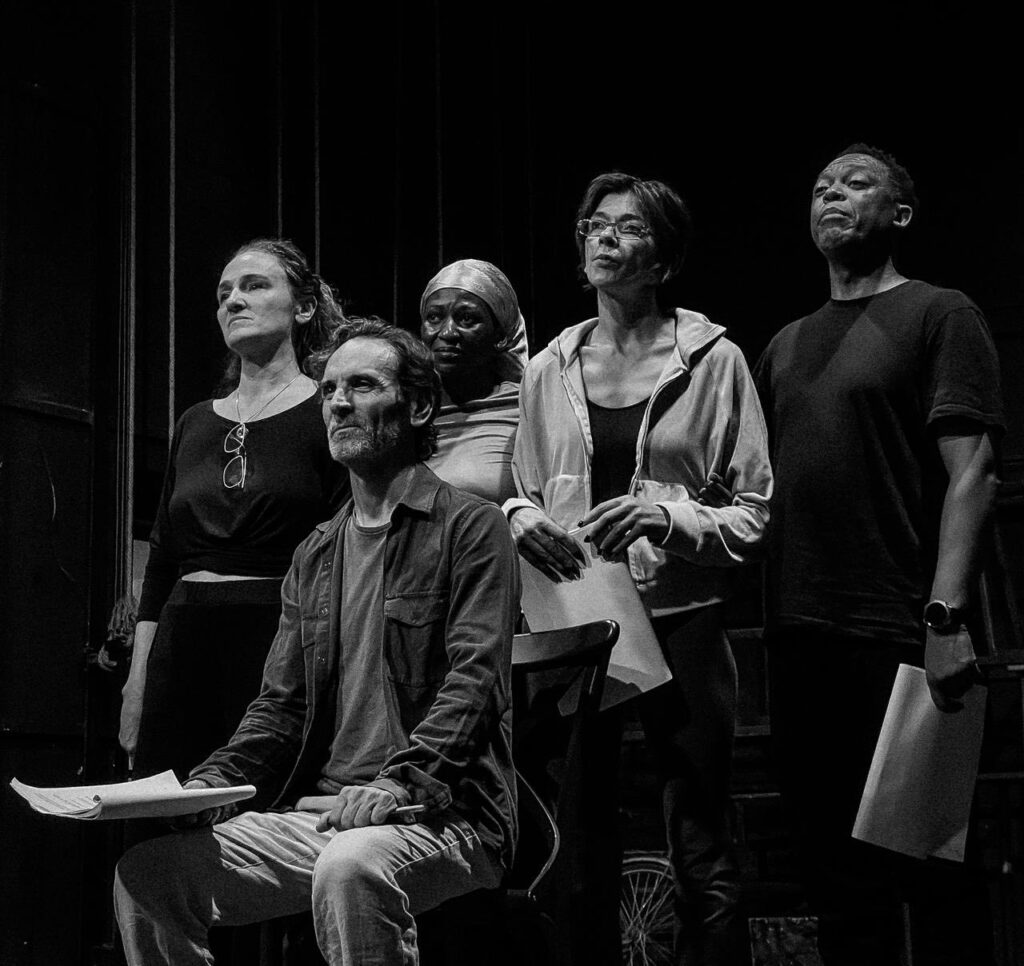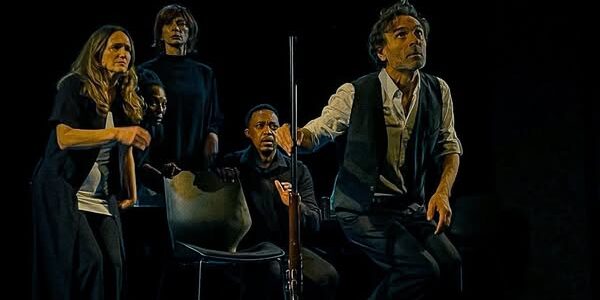Jeton Neziraj’s new play, Under the Shade of a Tree I Sat and Wept, explores reconciliation and forgiveness processes in Kosovo and South Africa. Andrej Čanji spoke to the creative team about their research process and how they’re bringing these topics to the stage.
‘This is one of the most complex theatre projects we have realised so far,” says Jeton Neziraj. The prolific playwright from Kosovo and the founder and director of the cultural organisation Qendra Multimedia, has tackled many complicated topics before. His recent work includes Negotiating Peace, about the process of brokering peace, and Prishtina: The Premeditated Killing of a Dream, about urban development in Kosovo and the murder of the architect Rexep Luci.
This new piece explores the process of public forgiveness which take place in Kosovo, when in 1990, when the country was on the brink of war, a group of former political prisoners, students and intellectuals launched a movement for the reconciliation of blood feuds. Generations of families had been trapped in cycles of vengeance, yet through public acts of forgiveness, where victims’ relatives addressed the families of their killers, more than a thousand feuds were resolved.
Five years later, South Africa’s Truth and Reconciliation Commission pursued a similar moral aim: confronting violence through truth-telling and forgiveness as instruments of national healing. Though arising from distinct contexts, both initiatives place forgiveness at the core of collective restoration and social cohesion. To create the piece, Qendra Multimedia has joined forces with the renowned Market Theatre in Johannesburg. Jeton Neziraj, and director Blerta Neziraj have joined forrces with dramaturg Greg Homann, the artistic director of the Market Theatre. While working on the project, they conducted extensive research, interviewed dozens of people in both Kosovo and South Africa, and worked with experts who helped them better understand and contextualise the issues.
“The fact that we were “tracing” something in such a distant and unfamiliar territory, and on such a sensitive subject, meant that we had to be extremely responsible. And I believe we were,’ says Jeton Neziraj.
“Both contexts speak to the human need to break cycles of violence and trauma,” explains Homann. “In Kosovo, forgiveness emerged from within a community as a collective act necessary to shift a longstanding cultural practice of vengeance; in South Africa, the Truth and Reconciliation Commission (TRC) was a national process across multiple communities that sought to confront systemic injustices through testimony and acknowledgement. What connects the two is the courage to face pain publicly, and to imagine coexistence where there had been division. Their differences lie in the social and political frameworks that shaped them – one grounded in tradition and culture, the other in a politically mandated oppression. For me, these contrasts are as important as their echoes; they remind us that there is no single model for forgiveness. Forgiveness is a continual negotiation of memory, pain, and empathy.”
“Of course, there are many differences between the two contexts,” Jeton Neziraj adds. “However, there are also numerous points of convergence, the most significant of which are poverty and oppression. The Albanians of Kosovo were the poorest people in the former Yugoslavia; they were treated as second-class citizens, but were also oppressed and persecuted. Naturally, the same was true for Black people in South Africa. To paraphrase Vladimir Arsenijević, I would say that the Albanians of Kosovo were the Black people of the former Yugoslavia.’
They wanted to explore, says Jeton Neziraj, “how forgiveness and reconciliation function not only through a racial lens, but also when they are generated and occur within, so to speak, one’s own kind. The process of examining, analysing, and identifying the commonalities between these two different contexts has been challenging – truly challenging – yet our outcome (both artistic and human) concerning the notion of forgiveness and reconciliation, I believe, is unique and refreshing.”
“It is the first time that we have collaborated with actors from Africa,” says director Blerta Neziraj. “But despite the fact that the process of making theatre differs between ours and that in South Africa – let’s say rehearsals there last much less than in ours – the greatest similarity is the sensitivity of the actors and of our theatre partner there, the Market Theatre, to political themes and political theatre. And this is not surprising, knowing the historical background of our two societies, in Kosovo and South Africa. Rarely in any theatre process have we had so many discussions as this time – endless, lively, and exciting.’
Collective creation
The project clearly emphasises collective creation. Jeton Neziraj explains that ‘initial rehearsals began with a broad “material for the stage,” which was then shaped, re-modelled, and reorganised by the dramaturg Greg Homann and the rest of the creative team.’
He adds: ‘Many scenes were generated through discussions with the actors, while others emerged from interviews with people or from archival materials.’
“The approach has been to find a theatrical treatment of the documentary material,” says Greg Homann, “so that it is understood not as static but as living narratives that articulate varied and often contradictory truths. The dramaturgical challenge was to honour the integrity of the sources while allowing space for poetic interpretation and theatrical licence. My early conversations with Jeton centred on how we might find an entry point that would allow the production to distil vast, complex histories into gestures, sounds, and moments that could speak across languages and continents without oversimplifying. Blerta’s task as director has then been to constantly balance respect for the voices of the past and the newly collected testimonies with the artistic freedom to make them resonate across our contemporary moment.”
“The structure of the text, and consequently of the show, is quite sharp and balanced,” says Blerta Neziraj. “This is also due to the fact that Jeton and Greg, in addition to the preliminary work, have collaborated with the rest of the performance team throughout the process. Many scenes and dramaturgical solutions evolved in the process, including suggestions for which scenes would require audio-visual “enhancement” with documentary materials. Beyond that, I am delighted that, in addition to the cast of six wonderful actors from South Africa, Kosovo, and Albania, I have also worked closely with other fantastic collaborators, such as German choreographer Jochen Roller, Dutch scenographer Theun Mosk, Kosovar video maker Besim Ugzmajli, and many others, to achieve this result—which we can now proudly share with the audience.’

Under the Shade of a Tree I Sat and Wept: in rehearsals
Documenting the past
“First, let’s be clear: any documentary material we place on stage is converted, filtered, and “manipulated” by the creators of the performance, in one way or another,” says Jeton Neziraj. Theatre is neither a courtroom that operates on the credibility of testimonies and the reconstruction of events, nor an antechamber of history. However, precisely for that reason, the aestheticisation of testimonies and real events demands responsibility, courage, and a high degree of sensitivity – both ethical and artistic.
How this balance between all these elements is achieved is a matter of each creator’s individual sensibility. But if we return to the metaphor of the “courtroom,” I would say that theatre presents all the “artistic facts,” yet does not deliver a final verdict. It merely suggests.
And what theatre suggests (even when it is not stated directly) is the recognition of human suffering, empathy with the oppressed and the victims, and the individual and collective encouragement to resist tyranny, oppression, and barbarity – whatever form of power they may stem from: political, social, religious, racial, etc.’
“I think that whenever we put art, theatre, in this case, in front of reality, we should recognise that we are dealing with two different worlds,” says Blerta Neziraj, “the first being fictional. On stage, everything is possible, as in our play, where at one point Anton Çetta, the leader of the Blood Reconciliation Movement in Kosovo, and Desmond Tutu, head of the TRC in South Africa, meet. In reality, they have never met. What I mean is that theatre offers “life models,” often impossible in reality, and these “life models” co-exist with us, perhaps in the same way that beautiful dreams co-exist with us… You know, when we are thirsty, we often dream of drinking water. Theatre takes us to those metaphysical realms… And even if fictionally, we exercise empathy, refine our feelings, and expand our viewpoints on life and the world… And this is something extraordinary.’
Can art achieve institutions cannot?
“Art does not reconcile in the way political institutions do; it doesn’t deliver closure or justice,” Greg Homann reflects. “What it can do is open emotional and imaginative space where empathy becomes possible. Theatrical space allows contradictions to coexist – it can hold grief and beauty, rage and tenderness, playfulness and pain, all on the same stage. In that sense, this piece of theatre invites an audience to experience questions of reconciliation not as an outcome but as an ongoing act of witnessing, contradicting, complicating, irreverence, and feeling. Where politics often demands resolution, the theatrical space allows us to spend a short time grappling with complexity and nuance in a way that hopefully allows for connection and fresh understanding to begin.’
Jeton Neziraj expands on this. “This working process for the performance has been enlightening for all of us on the team – for me, definitely. In particular, the examination and analysis of Desmond Tutu’s views on forgiveness and reconciliation, which, of course, have deep roots in religion, but also in the philosophy and popular culture of South Africa.”
“On the other hand, forgiveness and reconciliation in Kosovo – in the 1990 Blood Feud Reconciliation Movement – were inspired by entirely different motivations, grounded in the need for national unity and reflecting the fear of an approaching war. In other words, a collective cause was used to spark deeply individual acts.”
“In the performance, we have sought to explore the colour and texture of these two processes, which are connected but naturally not the same thing. And the fact that we now, in this time, recognise and reaffirm them by revisiting and bringing them up for reflection – these two values, historically significant for both societies in Kosovo and South Africa – I believe explains the very essence and approach of our artistic vision. And it proves that what art can do, politics never can,” he says.
Under the Shade of a Tree I Sat and Wept opens in Gjilan, Kosovo, on 17 October. It will then be performed at the Kosovo/North Macedonia Theatre Showcase on 29 October in Prizren, Kosovo.
Further dates will follow in South Africa and Europe in 2026 and New York in March 2027
For further information, visit: Qendra.org
Andrej Čanji is a theatre critic and theatrologist based in Belgrade.








